|
BOTTICELLI - MYSTERY NATIVITY
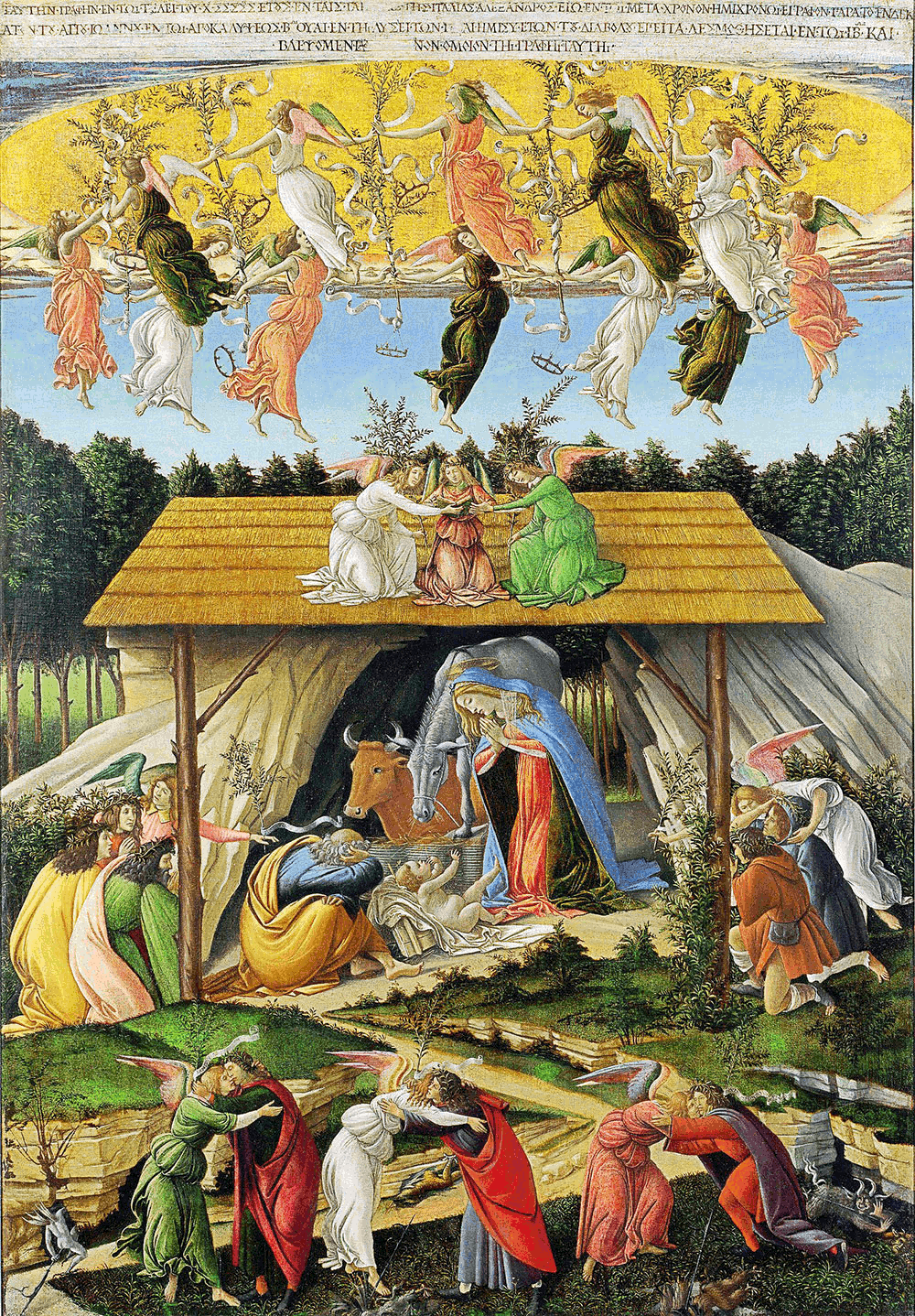
Sandro Botticelli, Public domain, via Wikimedia Commons
c. 1500–1501 |
- Sandro Botticelli, born as Alessandro di Mariano di Vanni Filipepi (1445-1510), was an Italian painter of the Early Renaissance.
-
Oil on canvas now located in the National Gallery in London.
-
The painting concerns the biblical Book of Revelation that
Botticelli believed he was living through in the early
16th-century.
- It is his only signed work and has an unusual iconography for a painting of the Nativity.
|
Botticelli's talent brought him into the sphere of
Florence's most powerful family: the Medici. As a
court artist, he produced works for Lorenzo de'
Medici, also known as Lorenzo the Magnificent. The
Medici were great patrons of the arts and fostered a
unique blend of Neoplatonic philosophy and Christian
humanism, which deeply influenced Botticelli’s themes.
(understandingitaly.com)
|
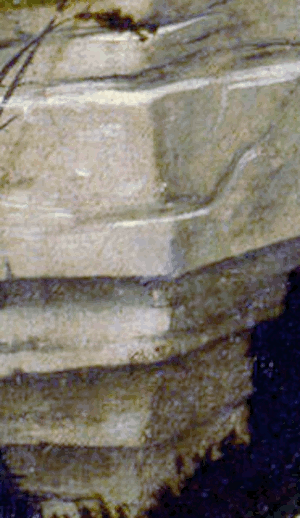
Foundation shifts |
-
Later in life, Botticelli’s style shifted dramatically under the influence of the Dominican friar Girolamo Savonarola (1452-1498).
- The friar preached against secularism and the excesses of Florentine society
to huge audiences during the last decade of the 15th-century.
- Botticelli was deeply affected by his fiery religiosity and
he began producing more austere religious imagery.
- Works
such as the Mystical Nativity shows a haunting and symbol-laden depiction of Christ’s birth that reflects spiritual anxiety and eschatological themes.
|
Botticelli associated these events with the turmoil mentioned in the biblical Book of Revelation, which talks about the end of the world and Christ’s second coming.
(nationalgallery.org.uk)
|
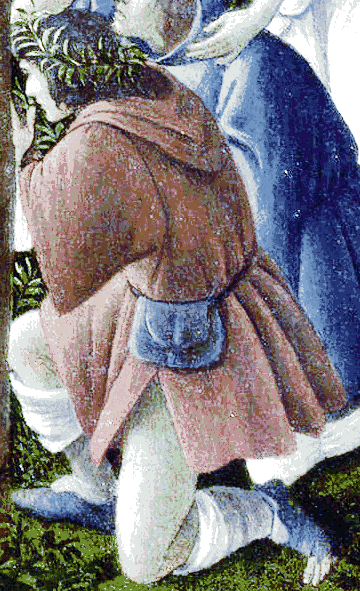
Biblical scene |
- It was after he ran into Friar Savonarola that Botticelli
changed the focus and theme of his artwork from Greek and
Roman mythology to biblical scenes.
- You might say that
under Savonarola’s influence, Botticelli reoriented his practice from decorative to devout.
- Savonarola criticized pagan and mythological artworks in particular
and early in his career, Botticelli specialized in this
genre.
|
Savonarola became regarded as prophetic, and thousands of Florentines would flock to listen to him preach. In one sermon, he purported that Florence could become the new Jerusalem if its civilians would part with and burn their luxuries, opulent fineries, and pagan or secular iconographies.
(hyperallergic.com)
|

Bonfire Botticelli's
work |
- Mystical Nativity is connected with the influence of Savonarola, whose
ideology appears in a number of late paintings by Botticelli.
- Savonarola preached against the moral decay of Florence.
- He called for a return to strict Christian values and led the infamous
Bonfire of the Vanities on Shrove Tuesday in 1497, where 'immoral' books, artworks, and luxury items were burned.
|
By the 1490s, the tension that resulted from the clash between courtly excess and those who wanted religious reform came to a climax when the preacher Savonarola preached his crusade to the people of Florence. One of the people influenced by the preacher was Botticelli, whose change of heart moved him to destroy some of his early painting by fire.
(italianrenaissance.org)
|
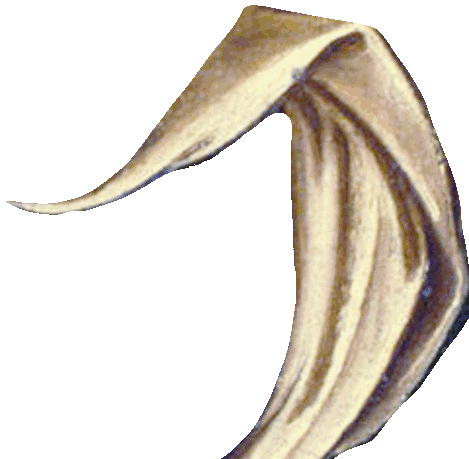
Proponent of burning everything down |
-
Savonarola professed that everything associated with moral weakness, including the finest Florentine Renaissance artwork, should be burned.
- The Mystic Nativity is said to represent a specific teaching of Savonarola
and has been described as a visual sermon.
- Savonarola
was said to be extremely hardcore in his beliefs and a dictator and extremist
who would burn and destroy anything he didn't agree with.
- He burned everything that didn't have a reference to
religion.
|
The three levels of the painting—top, center, bottom—do not connect naturally and do not flow together in landscape. Knowing Botticelli was a skilled artist well-schooled in the Philosophy of Beauty, we have to ask ourselves why he altered his style, or aesthetics, so dramatically, and consider how it reflected the religious, political, and personal turmoil of the turn of the century and (perceived) end of the world.
(kellybagdanov.com)
|

Rapture |
- The Mystical Nativity is a vision of peace on earth, but it comes in a moment of crisis: the Nativity unlocks the prophecy in Revelation and human history ends in
'rapture.'
- Botticelli's angels, spinning into paradise, are ecstatic; revolution hits the Holy Land.
- He believed that the apocalypse as described in the Bible was going to happen in 1504.
- Specifically, he believed that he was living in the Tribulation, a short period of time in which the world would suffer from hardship and disasters.
|
The rapture is a belief, primarily held by some Christians, that at the end times, all believers, both living and dead, will be caught up to meet Jesus in the air. This event is seen as distinct from the Second Coming, where Jesus returns to Earth to establish his kingdom.
(Assistant)
|
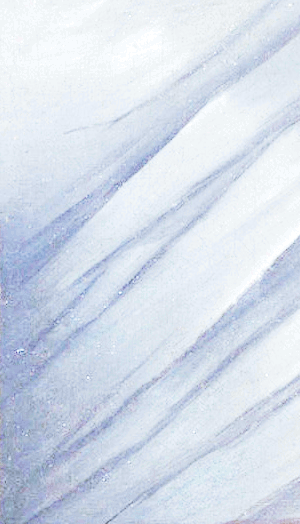
Apocalypse waves |
- Botticelli believed that the Millennium, a period of a
1,000 years during which Jesus would return to earth, would start in three and a half years.
- This belief of Botticelli was particularly based on the various wars going on at that time and the hanging, two years earlier, of the Florentine preacher Savonarola of whom Botticelli was a follower.
|
And the great dragon was thrown down, that ancient
serpent, who is called the Devil and Satan, the
deceiver of the whole world—he was thrown down to the
earth, and his angels were thrown down with him.
(Revelation 12:9)
|
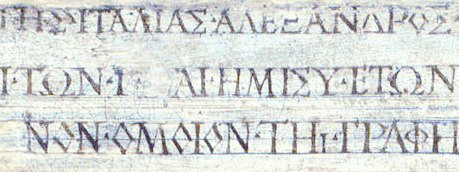
Greek inscription |
- The Greek
inscription
at the top of the painting mentions ‘the troubles of Italy’, a reference to the invasion of the French, who took Naples in 1494 and Milan in 1499, and to the civil strife in Florence itself.
-
There was even more upheaval in Florence at that time, due
to the spiritual and de facto reign of Savonarola,
the fanatical preacher.
- He aimed to morally reform the city
that had a global reputation for artistic output and lavish lifestyles.
|
The Greek inscription at the top translates as: 'This picture, at the end of the year 1500, in the troubles of Italy, I, Alessandro, in the half-time after the time, painted, according to the eleventh [chapter] of Saint John, in the second woe of the Apocalypse, during the release of the devil for three and a half years; then he shall be bound in the twelfth [chapter] and we shall see [him buried] as in this picture.
(brooklynrail.org)
|
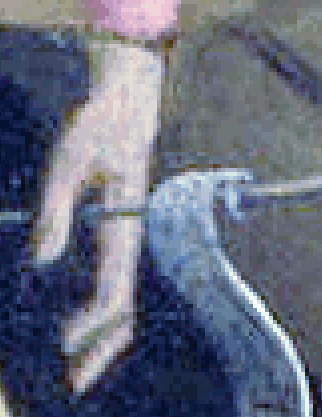
Witness |
- Revelation 11 tells of two witnesses who testify for three-and-a-half years and are then killed by the beast coming up from the abyss.
- The Second Woe has been and gone.
- Look, the Third Woe is coming soon.
-
There are hints of ‘Woe’ to come: the donkey bears on the neck the mark of a cross; the cave and swaddling-clothes portend burial.
- Yet the painting as a whole radiates joy.
|
The Mystic Nativity certainly recalls Revelation: in the open heaven (4:1), the twelve angels for stars above the Virgin (12:1), and those defeated devils (12:8). But the tone is so different: Botticelli’s angels have a playful grace, his devils are almost risible.
(thevcs.org)
|
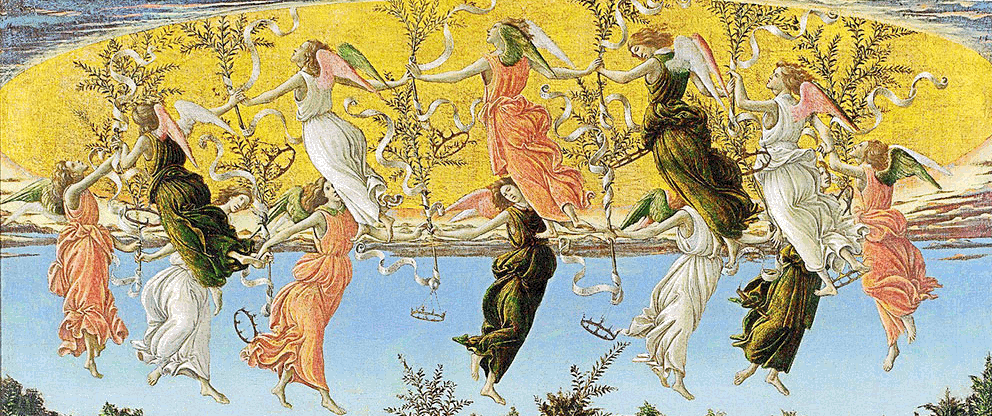
Golden dome |
- Underneath the top inscription, the painting is divided into three sections, the upper part shows the golden
dome of heaven opening above the scene below.
- From an opening in heaven, golden as the sun, a circle of
12 dancing angels links heaven and earth.
- All holding olive branches, seem almost to dance as they evoke the jubilation caused by the arrival of the Son of God.
-
The angels are suspended mid-air and above them heaven appears
and this
symbolizes harmony.
|
To create the heavenly dome Botticelli called on the goldsmith's craft he had learned as a boy. "The symbolism of the gold is to do with the unchanging, untarnished nature of heaven - gold doesn't decay, it doesn't darken like silver.
(travelingintuscany.com)
|
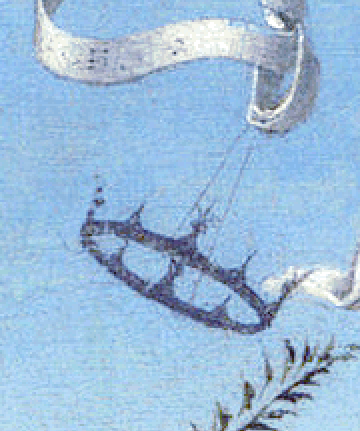
Symbolism |
- Golden crowns hang down from the dancing angels' olive branches.
- The golden dome of heaven has opened up entwined with scrolls and
intermixed with the crowns twirling along with the dancers.
- The crowns in the painting were mentioned in Savonarola’s Assumption Day sermon.
- Use
of the number 12 represents the 12 hours in a day, and the
12 months of the year, it's all astrology.
|
Gold does not decay or tarnish, so it was the perfect choice to stand for the eternal time of heavenly spaces. As the surface of the canvas is uneven, the gold is uneven as well, which produces a glittery, reflective surface.
(kellybagdanov.com)
|
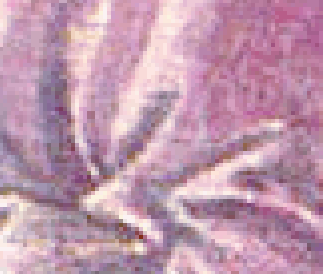
122 ribbons |
|
- The rebellious Italian Dominican friar and preacher, who wanted to reform religion in Florence,
heavily influenced this painting.
- Savonarola described his vision of a heavenly crown adorned with 12 ribbons inscribed in Latin with the unique mystical qualities or
'privileges' of the Virgin Mary.
- Each ribbon held by an angel contains one of the
12 privileges.
- On each branch flutters a ribbon with a Latin or Italian inscription in praise of the Virgin Mary: ‘Sanctuary beyond words’, ‘Mother of God’, ‘Virgin of Virgins’, ‘Wondrous Bride of God the Father’, ‘Virgin Mother’, ‘Hope of Sinners’, ‘Queen over All’, ‘Only Queen of the World.’
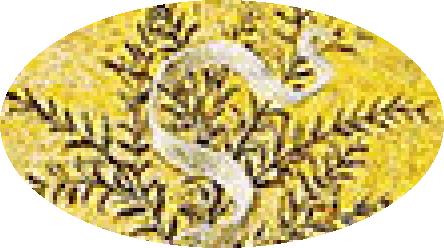
12 privileges or virtues |
- The banner described Mary as the 'mother of her
father' the 'daughter of her son' and the 'bride of God.'
- These mystical qualities were originally inscribed on the now
faded ribbons held by the 12 dancing angels at the top of
the painting.
- Botticelli had the ability to reinterpret ancient myths with a uniquely poetic
beauty and sensibility.
|
Here was an artist, working in personal and civic turmoil, who could look through and beyond it to a depiction—so uplifting—of its resolution. It is as if he could see dreams as strange and as wise as the dreams of Joseph.
(thevcs.org)
|
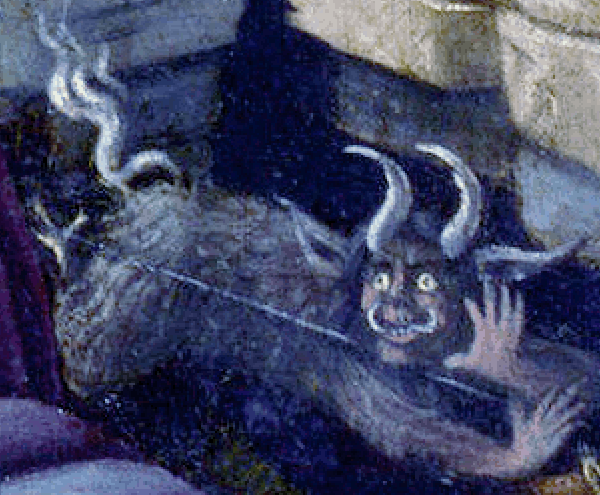
The Beast |
- Revelation describes a series of prophetic visions of
fantastical beasts and culminates in the Second Coming of
Jesus.
- The period of upheaval it described would end upon Christ’s return, when the devil would be buried, as in this
painting.
- Botticelli explored the 11th and 12th chapters of
the Book of Revelation
which are mentioned in the inscription.
|
Chapters 11 and 12 describe extraordinary events
including the opening of the temple of God in heaven,
a woman (often associated with the Virgin) who brings
forth a man child (associated with Jesus) who will
rule all nations and the great dragon (interpreted as
the devil) cast out of heaven.
(brooklynrail.org)
|
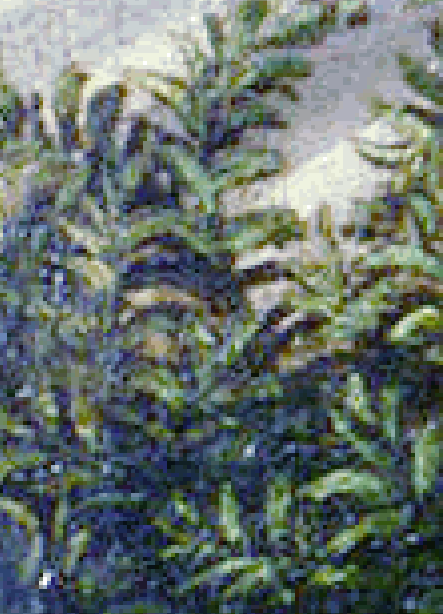
Vision |
- Savonarola interpreted these visions as emblematic of the city of Florence, identifying the dragon with the city’s contemporary tribulations and the beast’s defeat as marking the end to this period of upheaval.
- Botticelli began painting the Mystical Nativity just a few days after Savonarola’s famous Lenten sermon.
|
Botticelli remains one of the most revered painters of the Italian Renaissance. Celebrated for his lyrical style, mythological masterpieces, and profound religious imagery. Botticelli's work captures the elegance, emotion, and philosophical complexity of the era.
(understandingitaly.com)
|
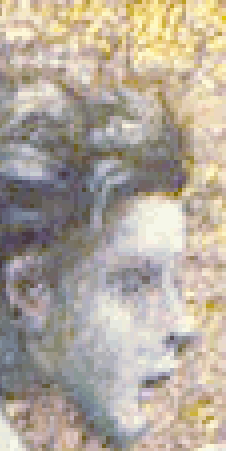
Intense |
- While much of the early Renaissance was
focused on rendering the body and space with natural beauty, Botticelli focused instead on the stresses of the soul.
- His strong religious beliefs and struggles became more
and more evident in his art, until his works became highly
emotional pictures with intense religious themes.
-
Eventually, Botticelli’s spiritual torment influenced his
decision to give up painting entirely.
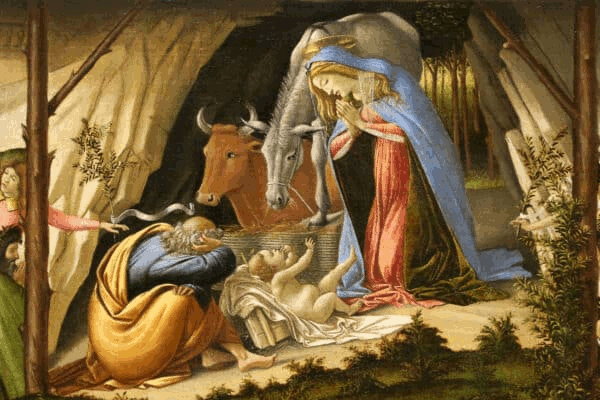
Family in manger |
- The infant Christ reaches up towards the Virgin Mary, oblivious of his visitors; the Three
Magi Kings on the left and the shepherds on the right.
- This painting uses the medieval convention of showing the Virgin Mary and infant Jesus larger than other figures
as they are the most important, and their surroundings.
- A tactic that was done deliberately for effect, as earlier works by Botticelli
he used correct graphical perspective.
|
The Virgin Mary, adoring a gigantic infant Jesus, is so large that were she to stand she could not fit under the thatch roof of the stable. They are, of course, the holiest and the most important persons in the painting.
(travelingintuscany.com)
|
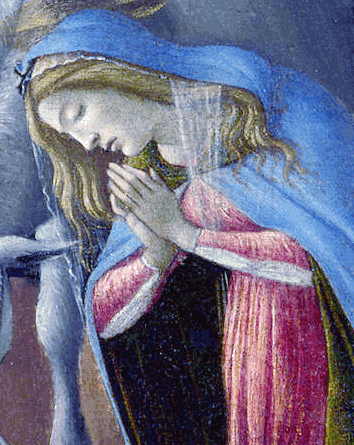
Traditional dress |
- Mary’s clothes show important symbology as she wears the traditional red dress which is the color of blood and signifies her humanity.
- Covering her is a blue cloak, which suggests the blue of the sky, or heaven, and divinity.
- In Mary’s clothing we have a visible reminder that she, a human, has carried the divine within her.
|
She brought forth a male child, one who is to rule all the nations with a rod of iron.
(Revelation 12:5)
|
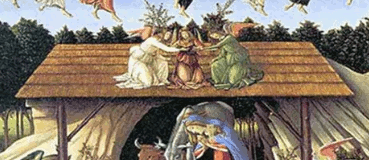
Thatched roof |
- The thatch roofed structure that acts as the stable is set
against a backdrop of cave and mystical forest.
- It's
impossible to see very far due to all the rock formations
and trees covered in fog.
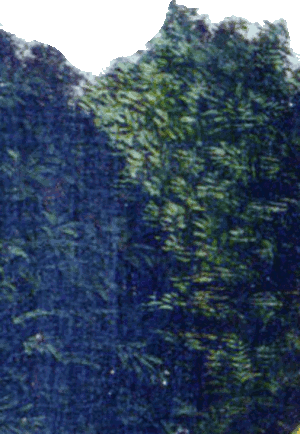
Mysterious wood |
- Behind the stable and a darkly mysterious wood, the Sun of Righteousness is about to rise.
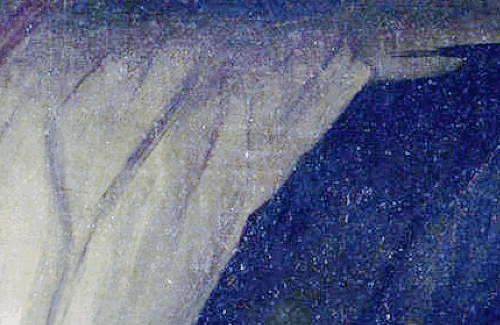
Cave |
- The nativity takes place in the stable which is
situated in front of two big rocks next to a cave.
- A scene that is a reminder of the crucifixion and burial of Jesus in a tomb.
- The cave, rather than a stable, is an early Christian symbol, which is still popular in Eastern Orthodox Christianity and iconology.
|
Christ’s infant presence in a cave suggests that the very depths of humanity in all its chaos and darkness is precisely where Christ comes to dwell and to redeem.
(sjp.org.uk)
|
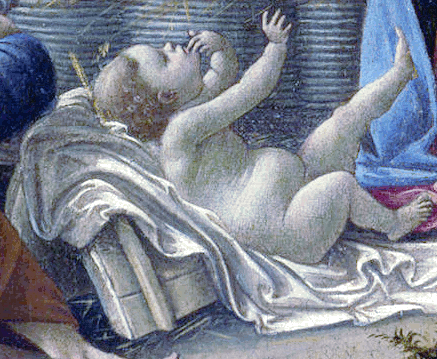
Baby Jesus |
- The infant Christ reaches out to his mother, dressed in
her traditional blue mantle and Mary is bending toward him, adoringly.
- She is not cradling the newborn, but worshipping him, demonstrating that Jesús is both her son and her Lord.
- The white sheet that infant Jesus rests on evokes
images of the shroud he was wrapped in after his crucifixion.
- The scrolls held by the angels pointing to the crib once read: `Behold the Lamb of God, which taketh away the sin of the world' the words of John the Baptist presenting Christ (John 1:29).
|
Baby Jesus is naked. Typically, Jesus is portrayed in one of two ways. Either naked, to emphasize his vulnerability, thus emphasizing how God left heaven to become human. Or, wrapped in swaddling clothes, which were intentionally painted to resemble funeral wrappings pointing the viewer to his eventual death.
(kellybagdanov.com)
|
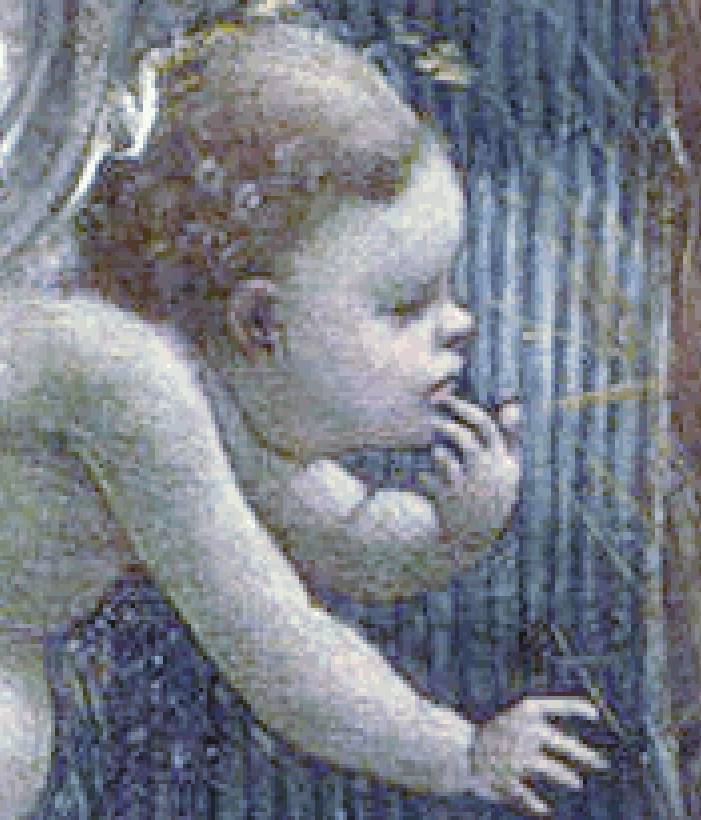
Baby Jesus
nude |
- Botticelli has chosen to depict the naked baby lying on his swaddling cloth, which has literally been kicked aside.
- Free from the typical depiction of an immobile baby
swaddled tightly in clothes that resemble the wrappings of
the dead, or a baby naked and vulnerable.
|
This baby has freed himself from his restrictions, kicking his feet and raising his hands, communicating Christ’s eventual victory over death. Instead of pointing toward death, Botticelli points us toward the resurrection.
(kellybagdanov.com)
|
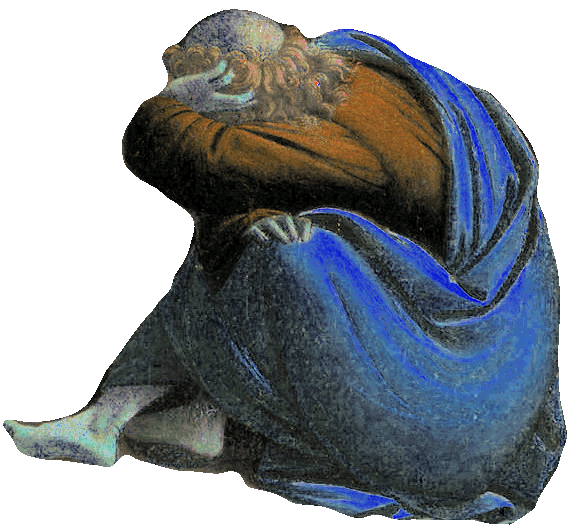
Joseph |
- Joseph sits on the ground next to the child, perhaps asleep, with his face not visible.
- Joseph is often painted as an older man who poses no threat to Mary’s virginity.
- Additionally, since Joseph is both a man and a sinner, he is often painted sleeping during the birth preserving Mary’s modest purity as well.
|
But after he had considered this, an angel of the Lord appeared to him in a dream and said, “Joseph son of David, do not be afraid to take Mary home as your wife, because what is conceived in her is from the Holy Spirit.
(Matthew 1:20)
|
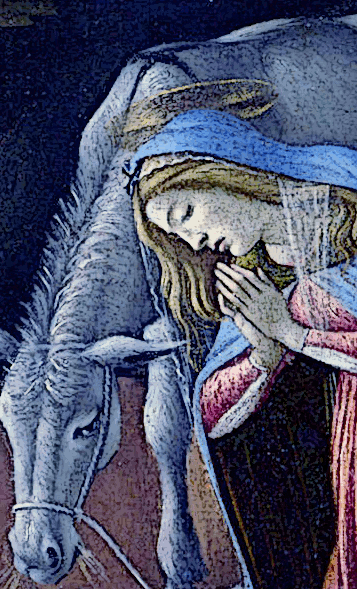
Watching over their king |
- A cursory glance depicts an ordinary Christian image.
- The Virgin Mary and Joseph dote over infant Jesus in his manger beneath the roof of an open-air wooden hut with their ox and
ass also called a donkey.
- The presence of these animals alludes to a verse in the book of Isaiah that states that the ox and ass will know their master, as even the animals will recognize their
'king' when he appears.
|
The painting is not just a classic Italian Renaissance image of the Nativity: it is a peace protest.
(sjp.org.uk)
|
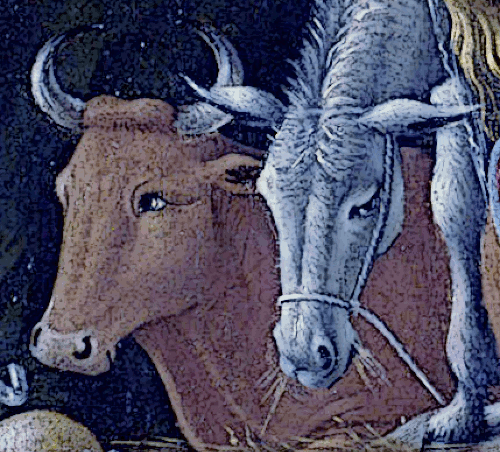
Ox and Ass |
Additionally, the ox, considered a 'clean' animal in biblical times, and the ass, considered an
'unclean' animal, are thought to represent the union of the Israelites and the
Gentiles.
- Their presence together testifies to the fact that the Messiah was intended not just for the Jews, but for all of humanity.
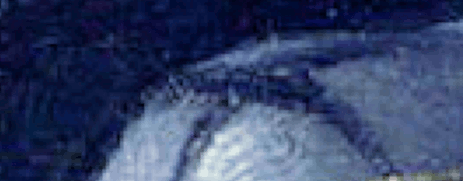
Cross on donkey's back |
- The mark of the cross is depicted on the hump of the donkey’s back.
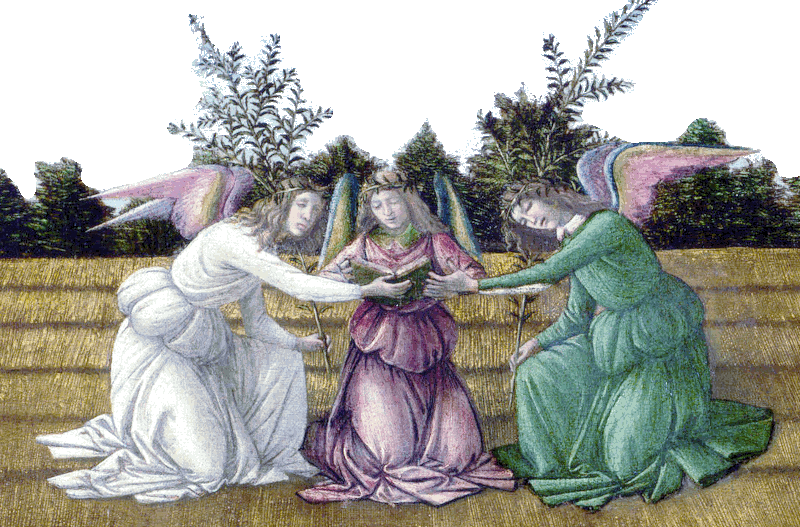
Archangels
Michael, Gabriel and Raphael |
- Angels are found throughout the entire piece, in far greater numbers
than normally expected.
- The angels are dressed in white, green, and red, which are, respectively, the symbols of faith
(white), hope (green), and charity (red).
- They are pulling people out of a state of religious limbo, saving them from the demons.
|
The green is a “true” green in most of the painting, however in this top section the angel’s robes have been burnished with gold so that they are no longer a pure green. It has been suggested that Botticelli altered the color because we are closer to heaven here, that “Hope” is no longer needed because it has come.
(kellybagdanov.com)
|
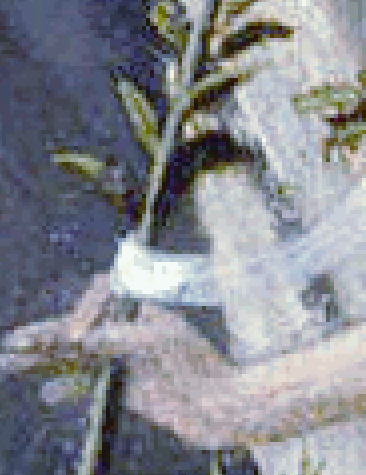
Olive branch |
- On one side the wise men represent the rulers of the world, on the other the
shepherds represent those who are ruled.
- Both groups are equally in need of the peace and reconciliation that the Christ Child brings.
- On either side of the main group an angel stands strong with an olive branch in their outstretched hand.
-
All except one of the angels bear branches of young olive, and there are
wreaths of young olive on the heads of the mortals.
- It would be hard to envision a lovelier depiction of the joy of heaven to earth come down.
|
Mercy and truth are met together; righteousness and peace have kissed each other.
Truth shall spring out of the earth; and righteousness shall look down from heaven.
Righteousness shall go before him; and shall set us in the way of his steps. (Psalm 85)
|
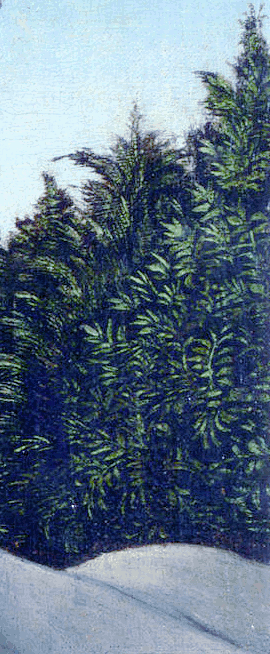
Christmas story |
- The following verses from were related to the Nativity by Savonarola in a sermon purportedly
delivered on Christmas Eve 1493.
- Mercy, Truth,
Righteousness, and Peace, which, Savonarola says, are simply four of the names that
David applied to Christ, were first united through his birth.
|
Behold, the sky opened, and right away I see
descending from the bosom of the Eternal Father a
venerable woman with an olive branch in hand, and she
came singing, Misericordia Domini plena est terra.
That is, the earth of the Holy Virgin was filled with
the mercy of the Lord. She urged and begged the Child
to come forth, and thus, Veritas de terra orta est.
Suddenly from this 'earth' was born Truth. The Holy
Child came forth. Then he set himself on the bare
ground in front of the Holy Virgin. Now as soon as
this Truth had come forth. (Savonarola)
|
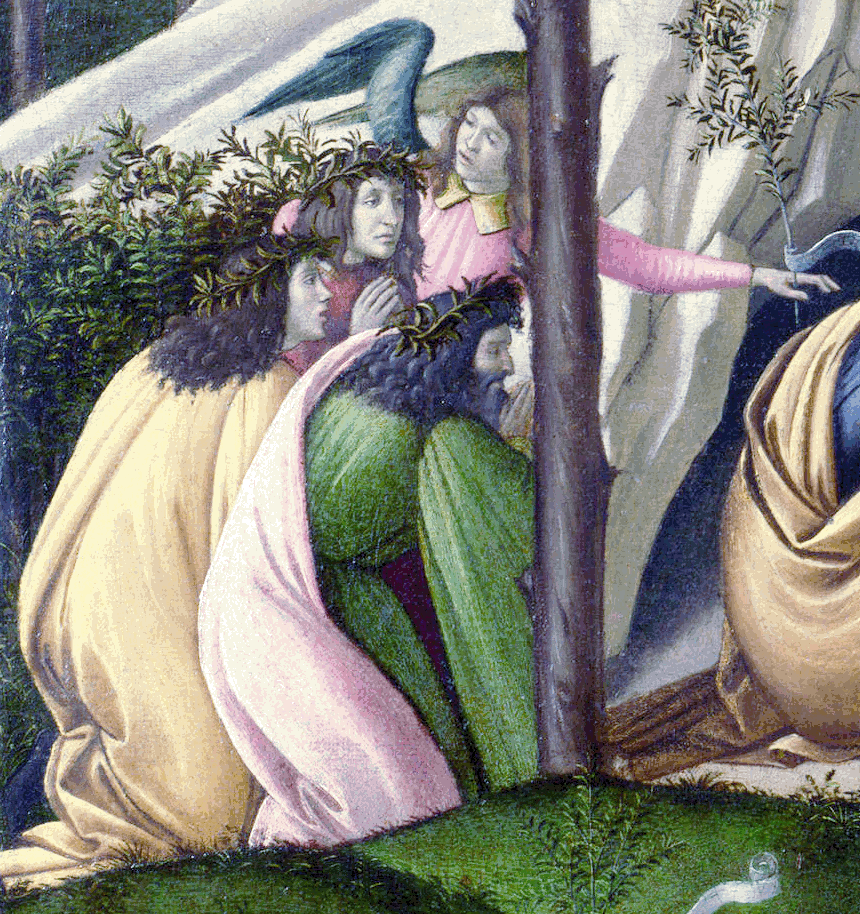
Adoration of the Magi |
- The angel on the left shows the child to three men in long,
simple gowns.
- These are the biblical Magi and this painting is another
version of Adoration of the Magi.
- Traditionally, the Magi were painted in elaborate clothes to emphasize that even the most powerful rulers will kneel to the King of Kings.
|
Interestingly, in the 1500’s, what is now celebrated as Palm Sunday was then called Olive Sunday, as the Prince of Peace was entering Jerusalem and carried the olive branch with him. Olive branches appear throughout this painting. See if you can spot them all as we travel down the canvas. Does their location comment on the presence (or absence) of peace?
(kellybagdanov.com)
|
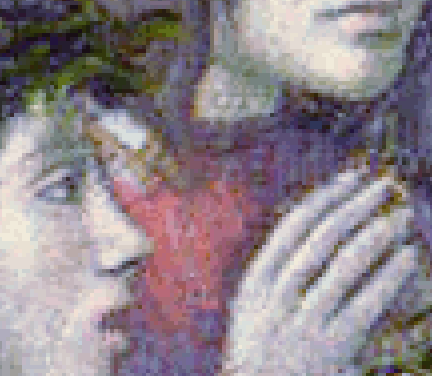
Magi empty-handed |
- Another
unusual aspect is that the three kings welcome Jesus
empty-handed, rather than with gold, frankincense, and myrrh.
- This is perhaps influenced by Savonarola’s sermon, though
it could be argued that the ultimate gifts are their prayers
and devotion.
|
We can see the influence of Savonarola’s teachings, who cautioned against such vanity, in Botticelli’s depiction of these figures. The beauty is in the act of adoration itself, not in the clothing worn by the wise men.
(kellybagdanov.com)
|
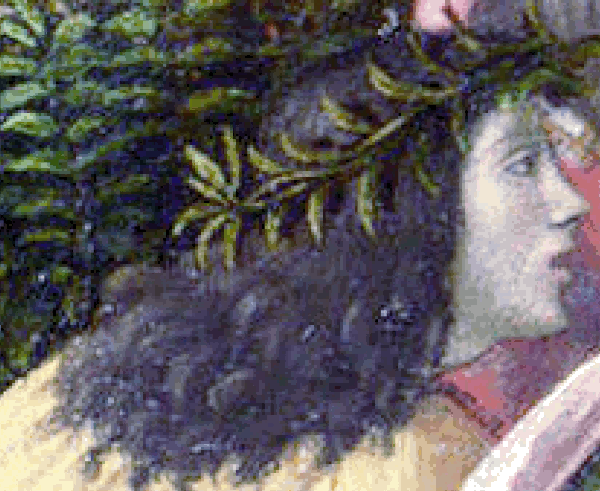
Crowned with olive branches |
- The group of five are kneeling and crowned with olive branches.
- They are also missing their traditional crowns, wearing instead garlands of olive, a symbol of peace and hope.
|
This is the Month, and this the happy morn
Wherein the Son of Heav’ns eternal King,
Of wedded Maid, and Virgin Mother born,
Our great redemption from above did bring;
For so the holy sages once did sing,
That he our deadly forfeit should release,
And with his Father work us a perpetual peace.
(Milton, Paradise Lost)
|
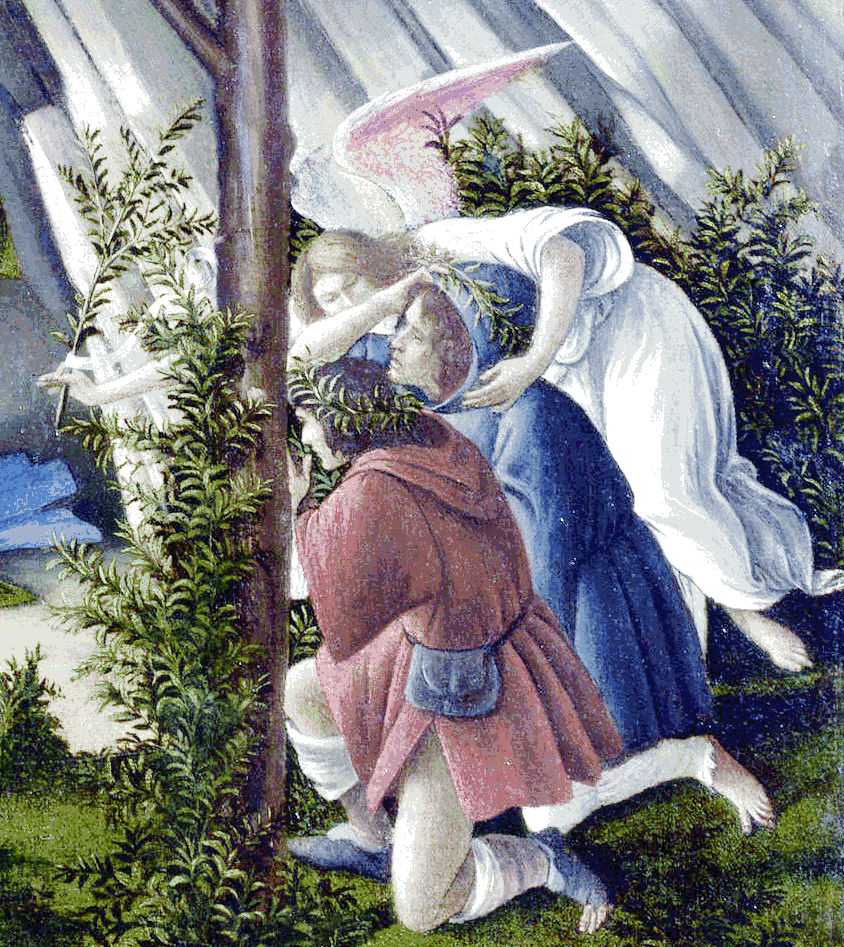
Shepherds |
- The angel on the right shows the child to two shepherds.
- According to Matthew, Jesus was visited by three wise men who followed a star to worship him.
- Luke describes that an angel announces the birth of Jesus to the shepherds and that they subsequently visit Jesus.
- Also, according to Luke, but not according to Matthew, the birth of Jesus happened in Bethlehem and Jesus was born in a stable.
- Botticelli combined elements from both gospels for this painting.
|
In his Mystic Nativity, Botticelli translated aspects of both the Apocalypse and of Savonarola’s visionary sermon into paint, connecting the glory of Mary with the imminent coming (or Second Coming) of Christ on Earth.
(brooklynrail.org)
|
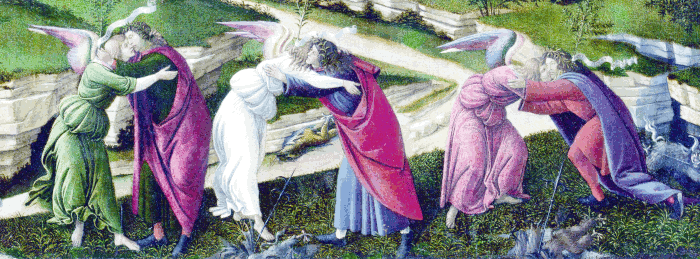
Three angels embrace three men |
- At the bottom of the work, three angels embrace three men also with olive
branches on their heads.
- Among their feet demons scuttle for shelter in the
underworld through cracks in the rocks.
- The imps at the bottom of the painting refer to the defeat of Satan
and their small size is another indication of the defeat of the devil.
- The scattering and impalement of the devils remind us that this vision of joy and love has been achieved through suffering and death, suggesting that this nativity might also be understood as a kind of
'Mystic Rebirth.'
|
Throughout the lower half of the painting, seven miniature devils flee into the fissures and crevices in their return to the underworld, with some impaling themselves on their own spears.
(Rhea Nayyar)
|
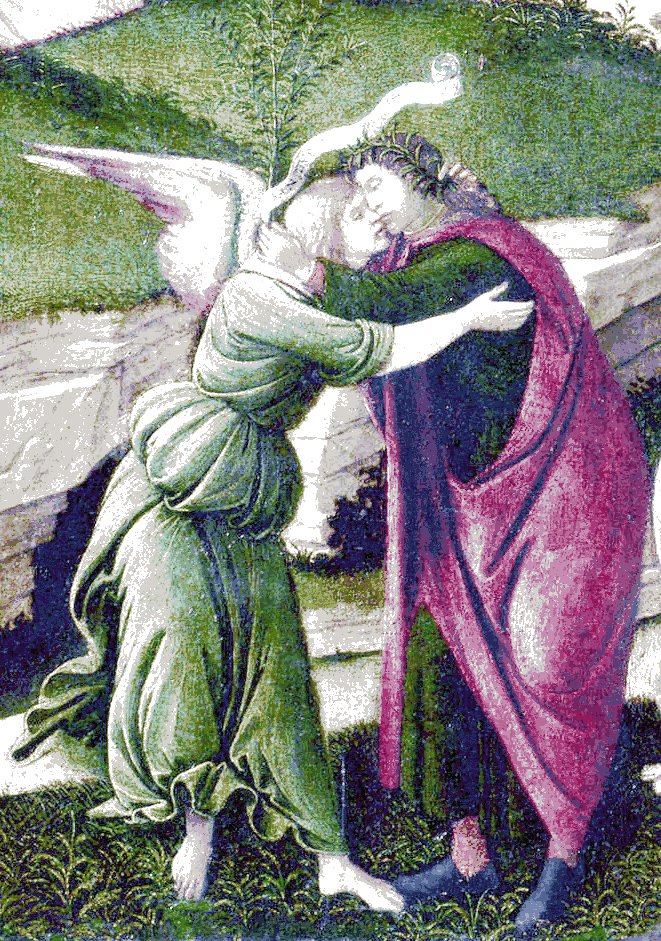
Angel hugs mortal man |
-
It appears the angels are pulling them out of limbo and
attempting to help the men kneel which is how they need to
approach the King of Kings.
- This is a symbol of the union between God and humanity.
- Savonarola’s message was to repent, distance yourself from demons and let the angels take you to the Savior.
- The inscribed scrolls held by the three embracing angels at the foot of the composition proclaim, in Latin,
'peace on earth to men of goodwill.'
|
Glory to God in the highest, and on earth peace, goodwill toward men.
(Luke 2:14)
|
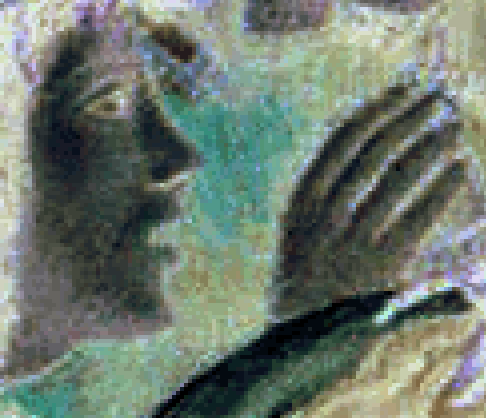
The judge |
- Accordingly, Botticelli’s work is not a straightforward nativity at all but an apocalyptic interpretation of contemporary event.
- It was a warning that he and his fellow Florentines would be judged and what was at stake was nothing less than their souls.
|
Also noteworthy is Botticelli’s decision to include three angels embracing mortal men in the foreground — a motif usually relegated to renditions of the Last Judgment in accordance with the Second Coming of Christ.
(Rhea Nayyar)
|
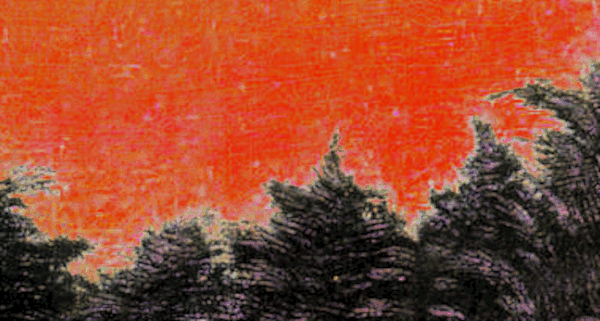
Red sky in Florence |
-
The political state of Florence became completely tied into religion and Savonarola’s beliefs became the politics of the time.
- As a result, the 'troubles' of Italy provided Savonarola an opportunity to step into the political vacuum caused by the expulsion of the Medici rulers of Florence.
- However, that didn't last long, Pope Alexander VI excommunicated Savonarola in 1497.
- Savonarola and his follower Fra Domenico da Pescia preached for almost exactly three-and-a-half years until they were burnt at the stake in May 1498.
|
The preacher met with the French king on behalf of the city and persuaded him to leave peacefully. Following this coup, Savonarola’s power grew, and on Assumption Day, 1496, he preached to a packed congregation, which may have included Botticelli himself, in the Cathedral of Florence.
(brooklynrail.org)
|
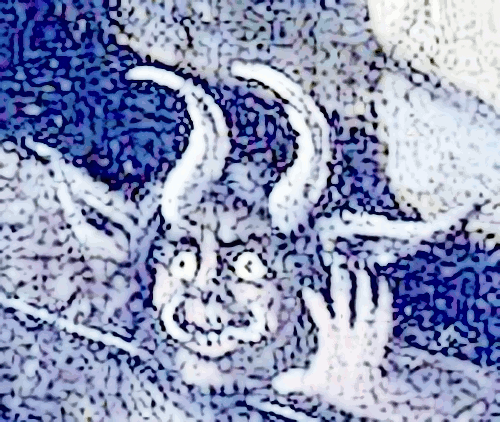
Questioning things |
- By 1500, after the flight of the Medici’s and the fall of Savonarola, Botticelli found himself in a vastly different position than he had a decade previous.
- Mystic Nativity is a religious painting; however, it is demonstrating how the church and state were more or less one
entity.
- The turmoil questioned understandings of beauty, truth, God, and art itself.
|
Botticelli was struggling spiritually and doubting his life’s work. Was his art glorifying God, or was it a vanity? Was it beautiful? And if so, what made it so? Had his intellectual, philosophical pursuits led him astray? Was he in danger of falling into one of the circles of hell Dante had described and he had illustrated? Was Christ’s second coming at hand and was he about to be judged?
(kellybagdanov.com)
|
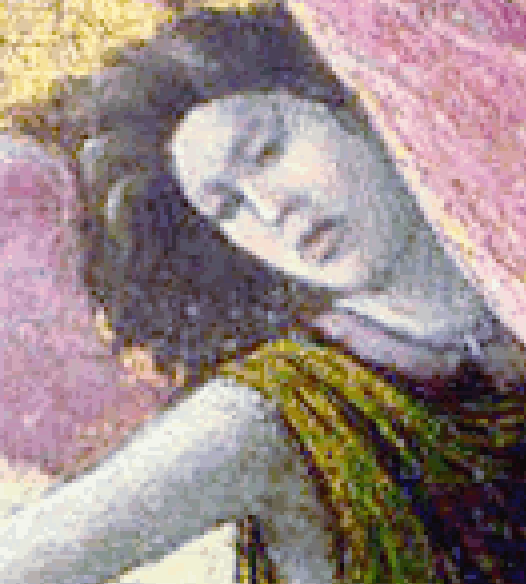
Hidden away |
- Botticelli used canvas, as opposed to wood for this painting, because canvas could be rolled and hidden
during a period of strict religious rule and abundent Inquisitions.
- This is perhaps because he knew that a visual record of
Savonarola’s sermon would have been dangerous now that
Savonarola had been declared a heretic and executed.
- As a result, the painting was hidden away for over 300
years.
|
In fact, Savonarola’s followers were searched out in an effort to root out the lingering political threat against the Medici family and the current Pope. Botticelli couldn’t risk being associated with them.
(kellybagdanov.com)
|
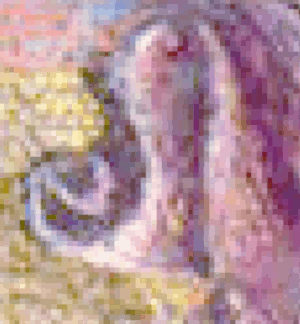
Coming together |
- Everything suggests a coming together of the celestial and the earthly and the era of peace expected to follow Christ’s return to Earth.
- This is not a Christmas card nativity scene as we know it, but a representation of spiritual struggle
and while there is joy and celebration, there is also pain.
|
Botticelli combined the traditional Nativity scene with apocalyptic visions of Christ's Second Coming and the end of the world. It symbolizes both Christ's birth and his return, emphasizing themes of salvation, reconciliation with God, and the triumph of good over evil.
(Assistant)
|
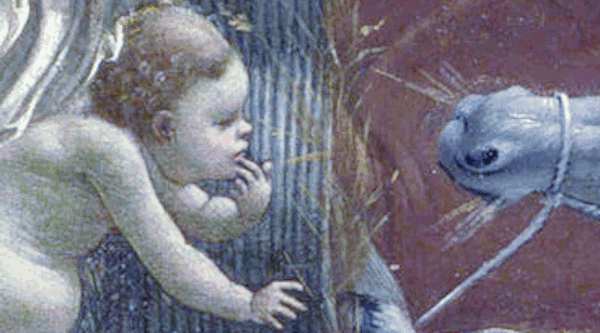
Unconventional |
- The depiction is certainly unconventional, and does not simply represent the traditional events of the birth of Jesus and the adoration of the shepherds and the Magi or
wise men.
- Instead, it is a vision of these events inspired by the
prophecies in the Revelation of Saint John and inspired by a
sermon from Savonarola.
- But what is most amazing is that
Botticelli originally supported Savonarola's radical dictorial
ideas, but at the end of his life saw the disastrous results
in the form of a Savonarola-created tribulation and it is
thought that Botticelli destroyed many of his own works.
-
What was better, the orthodox religious fanatic or the corrupt
government? Which is all the more reason to let Christ handle
it all.
|
Botticelli died in 1510. The Mystic Nativity remained
hidden for another three centuries. Rome at the end of
the 18th century was very different to Renaissance
Florence - except for the presence of French invaders.
(travelingintuscany.com)
|
|

